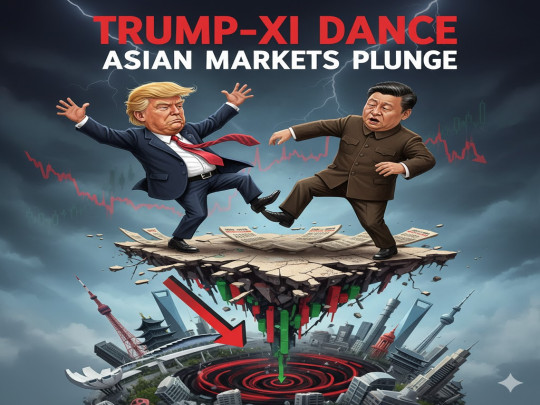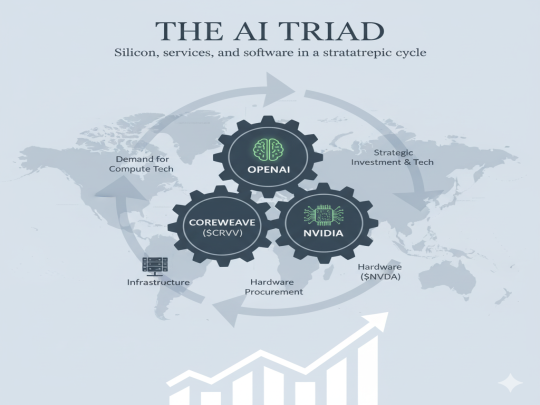Stock Market Update: Equities Rise on Trump’s EU Tariff Deal, Big Tech Earnings Ahead, Defense and Energy Stocks Rally
Stock Market Update: Equities edge higher as Trump announces new EU tariff deal. Nike rises on upgrade, Tesla climbs after chip deal with Samsung. Alphabet, Apple, Amazon, and Microsoft report earnings this week. Energy and defense stocks lead premarket gainers.

- Early Tuesday US stock futures were little changed as investors assessed a strong start to Q2 earnings season, with the S&P 500 and Nasdaq coming off record highs.
- Monday's market saw the S&P 500 (+0.14%) close above 6,300 for the first time and the Nasdaq (+0.38%) also hit a new record, driven by tech strength and earnings optimism.
- The rally was supported by a 4% surge in Verizon after its earnings beat and gains in big tech names like Alphabet.
- Significant premarket movers Tuesday included GM (-4%) and Lockheed Martin (-8%) falling on disappointing aspects of their earnings reports. Medpace (+45%) and D.R. Horton (+7%) soared on strong results. Opendoor (+13%) continued its meme-stock rally. M&A speculation boosted rail stocks like CSX
- Regarding trade, Treasury Secretary Bessent confirmed upcoming talks with China and signaled flexibility on tariff deadlines, though other officials reiterated the Aug 1 deadline is firm. The EU is weighing countermeasures to the threatened 30% US tariff.
- Treasury Secretary Bessent called for a broad internal review of the Federal Reserve's non-monetary operations. The economic data calendar is light until Wednesday.
- The Q2 earnings season is off to a strong start, with over 85% of early S&P 500 reporters beating EPS estimates. Bank of America notes profits are tracking a 5% YoY gain.
- Company earnings included GM beating Q2 profit estimates, though its core profit fell over 31% year-over-year. Coca-Cola also beat Q2 expectations, but global sales volume slipped.
- Global markets Tuesday saw Europe open lower, weighed down by tech stocks. Asia closed mixed, with China gaining while Japan and South Korea fell.
- US Treasury yields ticked higher Tuesday morning (10-year around 4.396%) as investors awaited comments from Fed Chair Powell.
- Gold prices held steady Tuesday near a five-week high. Oil prices fell for a third day on concerns that escalating US-EU trade tensions could hurt demand.
- Investor sentiment is being supported by a strong start to earnings season, which is currently outweighing trade concerns, though some strategists warn of potential complacency.
President Donald Trump announced a new trade agreement with the European Union on Sunday, just ahead of a key Friday deadline. Under the deal, most goods traded between the two economies, including automobiles, will face a 15% import tax. European Commission President Ursula von der Leyen clarified that some products, such as aircraft and select chemicals, would be exempt. While the 15% tariff is higher than the 10% initially proposed by the EU, it remains significantly lower than the 30% Trump previously threatened, offering a measure of relief to markets.
U.S. equity futures moved higher in early trading Monday in reaction to the deal, though gains were modest, suggesting a tempered response from investors. Market participants appeared cautious, possibly awaiting more clarity on the implementation and broader economic impact of the agreement. One sector that did see a strong reaction was defense, with shares rising in premarket trading following Trump’s comment that the EU would be purchasing “hundreds of billions of dollars worth of military equipment.”
The broader market also ended last week on a strong note. The S&P 500 rose on Friday to cap a winning week, supported by a robust earnings season and encouraging trade headlines. The Dow Jones Industrial Average climbed around 1.3% for the week, while the Nasdaq gained 1% and the S&P 500 added approximately 1.5%. The S&P 500 notched five consecutive record closes, finishing above 6,300 for the first time on Monday. The Nasdaq also reached new heights, surpassing the 21,000 level on Wednesday and logging four record closes throughout the week.
Earnings have played a key role in supporting the rally. Alphabet delivered better-than-expected results, helping lift the stock by 4% week-to-date. Verizon also saw a 5% gain after posting strong quarterly figures. As of now, more than 82% of the 169 S&P 500 companies that have reported earnings have topped analyst expectations, according to FactSet. This strong corporate performance has helped underpin the broader market’s upward momentum.
US Market Previous Day:
The U.S. stock market continued its upward momentum on Monday, with all three major indexes posting gains and fresh records. The S&P 500 rose 0.40% to close at 6,388.64, marking its 14th record close of the year. The Nasdaq Composite advanced 0.24%, ending at 21,108.32 for its 15th record close of 2025. Both indexes also reached new intraday all-time highs during the session. The Dow Jones Industrial Average gained 208.01 points, or 0.47%, to finish at 44,901.92. The blue-chip index is now less than 0.25% below its all-time closing high of 45,014.04 set on December 4.
US Futures Remain in Green:
- Dow Jones Industrial Average futures remained flat with rise of 0.04%
- S&P 500 futures showed meagre gains of 0.17%
- Nasdaq Composite futures lead the pack with gains of 0.33%.
Biggest Premarket Movers
- Energy stocks: Many U.S. energy companies saw their shares jump after the European Union agreed to purchase $750 billion worth of U.S. energy as part of a new trade deal. Shares of Venture Global climbed 6%, New Fortress Energy rose 5%, Cheniere Energy and NextDecade rallied nearly 4% each, Eaton and Constellation Energy each added about 2%, and EQT moved up more than 1%.
- Nike: Shares added 4% after JPMorgan upgraded the athletic apparel maker to "overweight" from "neutral." The firm expressed confidence that the company can recover over the next several years.
- Defense stocks: Military and defense companies rose in premarket trading on Monday. The gains came after President Donald Trump announced that the EU would be “purchasing hundreds of billions of dollars worth of military equipment” as part of the broader trade agreement. Kratos Defense and Security Solutions and Lockheed Martin advanced 2.3% and 1%, respectively, while RTX gained about 1%.
- ASML, STMicroelectronics: U.S.-listed shares of these European semiconductor-related companies gained on the back of the new U.S.-European trade deal. Equipment maker ASML rose 3.7%, and manufacturer STMicroelectronics gained 1.4%.
- Stellantis: Shares of the Netherlands-based maker of Chrysler and Jeep automobiles slipped 3%. The decline followed the announcement of the U.S.-European trade deal, which imposes a 15% blanket tariff on EU goods, including automotive products. The European Automobile Manufacturers Association stated that the levies will continue to negatively impact the industry.
- PagerDuty: The cloud computing provider popped 6% following a Reuters report that the company is exploring a potential sale after receiving interest from potential buyers.
- Cisco Systems: The maker of computer networking equipment lost 1.3% after being downgraded to "in line" from "outperform" at Evercore. The investment bank suggested that any potential upside for Cisco is now largely priced into the stock.
- Revvity: Shares of the biotechnology company sank nearly 6% after it cut its full-year 2025 earnings forecast. The diagnostics researcher now expects adjusted earnings between $4.85 and $4.95 per share, down from prior guidance of $4.90 to $5.00, with the new midpoint falling below the consensus estimate of $4.93. The weaker outlook overshadowed a beat on its latest quarterly results.
- Tesla: The EV-maker added 1.6% after CEO Elon Musk confirmed on Sunday that Tesla has signed a significant $16.5 billion chip contract with Samsung Electronics.
- Texas Instruments: The stock rose 1.3% following an upgrade to "outperform" from "peer perform" at Wolfe Research. The firm indicated it sees a cyclical recovery ahead for the chipmaker as it nears the end of a multiyear capital spending cycle.
Tariff Update:
President Donald Trump announced Sunday that the United States has reached a trade agreement with the European Union, just days ahead of the August 1 tariff deadline. The deal imposes a 15% tariff on most European goods entering the U.S., including automobiles. However, some key categories—such as aircraft and components, certain chemicals, and pharmaceuticals—will be exempt, according to European Commission President Ursula von der Leyen. Importantly, the new 15% tariff will not be additive to existing duties.
While the rate is lower than the 30% Trump had previously threatened, it remains well above the 10% target the EU had aimed for. In return, the 27-nation bloc has committed to purchasing $750 billion worth of U.S. energy and pledging $600 billion in additional investments into the U.S. economy beyond current levels. Though the deal averts a near-term tariff escalation, European leaders have warned that the agreement places the region at a disadvantage.
Meanwhile, trade negotiations between the U.S. and China are resuming this week in Stockholm, with senior officials from both countries seeking to avoid the reimposition of tariffs that could exceed 100%. The talks come ahead of an August 12 deadline for a durable agreement to replace the preliminary truce reached in June.
Expectations for a breakthrough remain low, but the meetings are seen as a critical step toward de-escalation and potential high-level talks later this year between President Trump and Chinese President Xi Jinping. Thus far, discussions have focused narrowly on tariffs and trade balances, without addressing deeper structural concerns. These include U.S. objections to China’s state-led economic practices and Beijing’s grievances over national security restrictions on tech exports.
Key Economic Data/News:
This week, investors will closely watch the Federal Reserve's two-day policy meeting, which concludes on Wednesday. While the central bank is widely expected to keep its benchmark short-term interest rate unchanged at the current range of 4.25% to 4.5%, markets will be focused on any forward guidance that could hint at a potential rate cut in the September meeting. In addition to Fed commentary, attention will turn to key economic data releases that may influence future policy decisions.
The first estimate of second-quarter GDP growth, set to be released by the Commerce Department on Wednesday, will offer fresh insight into the state of the U.S. economy. Economists surveyed by Dow Jones expect an annualized growth rate of 2.3% for the April–June period, a significant rebound from the 0.5% contraction seen in the first quarter.
Inflation will also be in the spotlight later in the week, particularly on Thursday when the June personal consumption expenditures (PCE) price index is released. As the Fed’s preferred inflation gauge, the report is expected to show core inflation (excluding food and energy) remaining steady at 2.7%, while headline inflation is projected to rise to 2.5%. Both the core and headline monthly figures are anticipated to increase by 0.3%.
Labor market data will round out a busy week of economic indicators. The Job Openings and Labor Turnover Survey (JOLTS) is due Tuesday, followed by ADP’s private payrolls report on Wednesday. On Thursday, weekly jobless claims will be released, leading up to Friday’s highly anticipated July jobs report. Economists expect a moderation in hiring, with payrolls projected to rise by 102,000, down from 147,000 in June. The unemployment rate is forecast to tick up slightly to 4.2% from the previous month’s 4.1%. These data points will be closely scrutinized for signs of labor market cooling and their implications for monetary policy.
Earnings Season/Company News:
This week marks a major stretch in the second-quarter earnings season, with roughly 30% of the S&P 500 scheduled to report results. Big Tech companies are at the forefront, with Microsoft, Meta, Amazon, and Apple all set to announce their quarterly earnings. Investors are expected to closely analyze commentary around artificial intelligence-related spending, seeking confirmation that this year’s substantial investments in hyperscale infrastructure are delivering value.
Beyond the tech sector, several large-cap names are also due to report, including Boeing, Ford, and Starbucks. While expectations heading into the season were relatively muted, the results so far have been encouraging. As of Monday morning, more than 30% of the S&P 500 companies had reported, with over 82% surpassing analysts’ earnings forecasts, according to FactSet. This better-than-anticipated performance has helped sustain bullish sentiment across equity markets.
Global Market Trends:
ChatGPT said:
European markets climbed to a four-month high on Monday, buoyed by strength in pharmaceutical and semiconductor stocks, as well as renewed optimism following a trade agreement between the European Union and the United States. The deal, reached ahead of the August 1 deadline, helped ease concerns about steep auto tariffs and fueled a rally in Europe’s carmakers. The broad-based STOXX 600 index gained ground and is now trading just 1.8% below its all-time high from March 4. The index has rebounded nearly 20% from its April lows, driven by expectations of additional trade deals and a resilient earnings season.
In Asia, markets closed mixed as investors weighed regional economic data and global trade developments. Hong Kong’s Hang Seng Index rose 0.68% to 25,562.13, while China’s CSI 300 posted a modest 0.21% gain to finish at 4,135.82. South Korea’s Kospi advanced 0.42% to 3,209.52. Australia’s S&P/ASX 200 also moved higher, ending the session up 0.36% at 8,697.70, supported by strength in mining and financial shares.
Debt Market:
In the U.S. debt market, Treasury yields remained largely flat on Monday, as market participants positioned themselves ahead of the Federal Reserve’s upcoming policy decision and a key inflation report later in the week. The benchmark 10-year yield ticked up by one basis point to 4.398%, while the 2-year yield was unchanged at 3.923%. The 30-year yield edged slightly lower to 4.923%. Futures markets are overwhelmingly pricing in a pause in rate changes at this week’s Fed meeting, with a 97% probability of rates being held steady, according to the CME FedWatch Tool. Investors are now more focused on the Fed’s tone and any clues about the path of policy beyond July.
Commodities:
Gold prices held steady to start the week, as competing forces kept the precious metal in a narrow range. Improved risk sentiment following the U.S.-EU trade agreement reduced safe-haven demand, applying downward pressure on gold. However, that same deal also lessens inflation uncertainty, potentially paving the way for a more dovish Federal Reserve later this year—a factor typically supportive for gold. With the Fed’s policy decision looming midweek, investors are reluctant to take large positions, keeping gold largely range-bound for now.
Crude prices edged higher on Monday as traders reacted to the reduced geopolitical uncertainty following the U.S.-EU trade deal. The agreement helped shift market focus back toward supply-demand fundamentals. However, a strong U.S. dollar and a decline in Indian crude imports capped gains. On the supply side, an OPEC+ technical panel meeting Monday is expected to maintain the current output strategy, with no major adjustments anticipated. According to ING, the group is still on track to fully reverse the 2.2 million barrels per day in voluntary supply cuts by the end of Q3.
Market Sentiment:
The bull market remains intact, underpinned by stable inflation, range-bound interest rates, and a stronger-than-expected earnings season. These supportive fundamentals continue to offer a constructive backdrop for equities. However, several headwinds are emerging that could spark near-term volatility.
Tariffs remain a key source of uncertainty. While the recent U.S.-EU trade deal eased some concerns, corporate commentary continues to highlight lingering apprehension over trade policy. Risks to Federal Reserve independence and the potential economic fallout from tariffs—particularly with the White House’s August 1 deadline approaching—could also weigh on sentiment. Additionally, concerns over rising U.S. debt levels may increasingly capture investor attention.
Equity valuations have climbed alongside a multi-week rally that has pushed major indexes to fresh record highs, leaving markets more vulnerable to negative surprises. With over 150 S&P 500 companies—including tech giants Meta and Apple—scheduled to report earnings next week, investor focus will remain squarely on corporate results and guidance. The Federal Reserve’s upcoming policy meeting is also in the spotlight, though markets widely expect no change to the current 4.25%-4.5% rate range.



